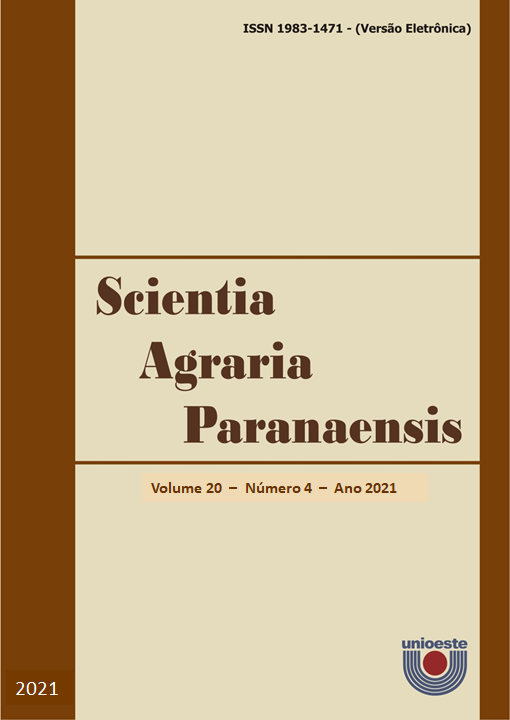Agriculture performance of table cassava cultivars in west region of Pará
DOI:
https://doi.org/10.18188/sap.v20i4.28330Resumen
The cassava crops have a great diversity of cultivars, mostly creole, being necessary studies that aim the selection of materials able to express its productive potencial in distinctive areas of Brazil. Thus, this work aimed to assess the agronomic characteristics and the productive of seven cultivars of table cassava, in the West region of Pará. The experiment was carried out in a rural property, in the municipality of Mojuí dos Campos (Pará). The experimental design was randomized blocks, with three repetitions. The treatments were constituted of local cassava cultivars (Água Morna, Roxa do Curudi, Amarelona, Olhinho, Máximo, Tabocal II e Paço Branco). The evaluated characteristics were: height of plants – HP (m), height of the first ramification – HR (m), diameter of the plant stem – DPS (cm), number of sprouts - NS, number of harvested roots - NHR, root fresh biomass – RFB (g), root dry biomass – RDB (g), diameter of roots –DR (cm), length of roots – LR (cm) and productivity (PR). For the characters in the aerial part, the ‘Roxa do Curundi’ cultivar showed the highest HP and HR ‘Máximo e Paço Branco’ expressed the highest DPS and NS, respectively. The cassava cultivars studied distinguished as to the characteristics of agronomic interest for inclusion in plant breeding programs of the species in the western region of the state of Pará. Among the evaluated cultivars, ‘Paço Branco’ is recommended for agricultural improvement, as it presents desirable characteristics, such as higher productivity and smaller size.
Descargas
Publicado
Cómo citar
Número
Sección
Licencia
Aviso de Direito Autoral Creative Commons
Política para Periódicos de Acesso Livre
Autores que publicam nesta revista concordam com os seguintes termos:
1. Autores mantém os direitos autorais e concedem à revista o direito de primeira publicação, com o trabalho simultaneamente licenciado sob a Licença Creative Commons Attribution que permite o compartilhamento do trabalho com reconhecimento da autoria e publicação inicial nesta revista.2. Autores têm autorização para assumir contratos adicionais separadamente, para distribuição não-exclusiva da versão do trabalho publicada nesta revista (ex.: publicar em repositório institucional ou como capítulo de livro), com reconhecimento de autoria e publicação inicial nesta revista.
3. Autores têm permissão e são estimulados a publicar e distribuir seu trabalho online (ex.: em repositórios institucionais ou na sua página pessoal) a qualquer ponto antes ou durante o processo editorial, já que isso pode gerar alterações produtivas, bem como aumentar o impacto e a citação do trabalho publicado (Veja O Efeito do Acesso Livre).
Licença Creative Commons
Esta obra está licenciada com uma Licença Creative Commons Atribuição-NãoComercial-CompartilhaIgual 4.0 Internacional, o que permite compartilhar, copiar, distribuir, exibir, reproduzir, a totalidade ou partes desde que não tenha objetivo comercial e sejam citados os autores e a fonte.


